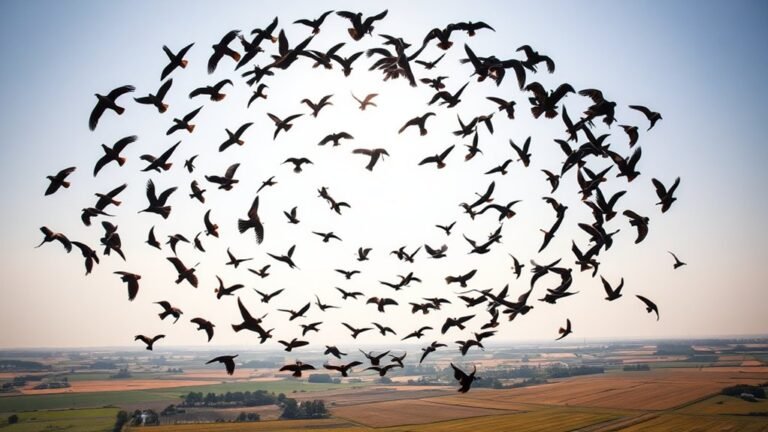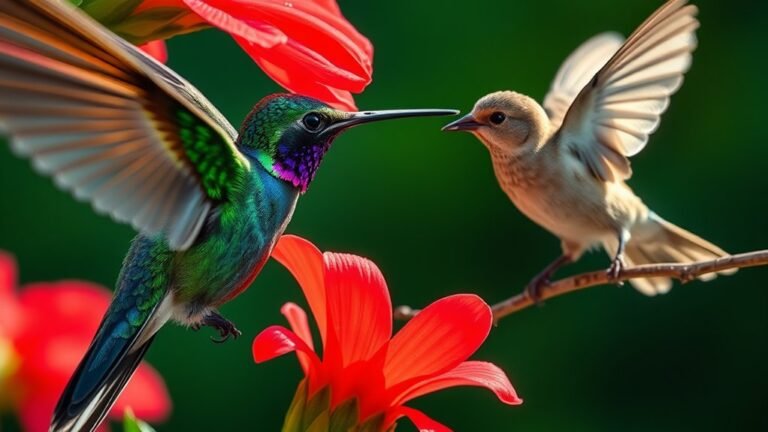4 Best Chew Toys for Destructive Birds
Discover four top chew toys that prevent destruction and keep your bird entertained—find out which options could be a game-changer for your feathered friend’s habits.
Discover four top chew toys that prevent destruction and keep your bird entertained—find out which options could be a game-changer for your feathered friend’s habits.

Some birds chirp at night, and they do so for important reasons. These nighttime calls help them attract mates and defend their territory. Birds have adapted to singing under the moonlight. Each species has its own unique song, which raises interesting questions about how their biology connects with their environment. Studying these nighttime songs provides valuable insights into bird behavior and ecology. Understanding why they sing at night enriches our appreciation of their world.

Have you seen birds flying in a V-formation? This pattern is not random; it follows specific rules. The V-formation helps birds save energy by reducing wind resistance. It also improves their communication with each other and helps them navigate during migration. When birds stay in formation, they show teamwork and social behavior, which are crucial for their long journeys. Let’s take a closer look at how V-formation flying works.

Birds often fly in front of cars, which can seem dangerous. This behavior results from their instinctual drives and the difficulties they face in city environments. As they look for food and navigate their surroundings, they sometimes misjudge the speed and distance of approaching vehicles. This miscalculation can lead to risky situations. To keep both birds and drivers safe, we can consider some strategies. Installing bird-friendly signage, reducing speed limits in areas with high bird activity, and creating more green spaces can lower the chances of these encounters. Understanding these behaviors helps us find better ways to coexist with birds in urban settings.

When you see birds flying in circles above, you witness their natural behavior. These movements serve a purpose. Birds use this technique to communicate with each other and find food. Their spiral patterns can also symbolize unity and personal growth. As you watch them, consider the connections between their actions and your own life. This reflection can offer insights that blend scientific understanding with personal meaning.

Birds flying in circles often catch our attention. This behavior is not just for show; it serves important purposes. Circular flight helps birds save energy, stay safe in groups, and find their way. When birds fly in a circle, they work together. This group movement protects them from predators. Flocking also allows them to keep an eye on each other, creating a sense of security. Different bird species use various circling techniques. Some take advantage of wind currents to glide without using much energy. Others may circle to communicate or coordinate their next move. Understanding why birds fly in circles gives us insight into their survival strategies. This behavior highlights their ability to adapt and thrive in their environment. Observing these patterns can deepen our appreciation for these remarkable creatures.

Have you seen birds flying in circles? This behavior helps them survive. By flying together in circles, birds keep an eye on each other and work better as a group. They communicate, spot dangers, and find their way around at the same time. What causes these flying patterns? Learning about how birds flock shows us interesting details about their behavior.

When you watch birds, you may see them flap their wings while staying on the ground. This behavior has many important purposes. It is not just about flying. Birds use wing flapping for courtship displays and to show dominance. Each flap carries meaning and helps birds communicate with each other. Understanding these actions reveals how birds interact with their environment and with one another. The reasons behind these behaviors are interesting and can change how we think about bird life. Engaging with this knowledge can deepen our appreciation of these fascinating creatures.

When you watch birds that look like swallows, you will notice their strong flying skills and social behaviors. Birds like the Barn Swallow and Tree Swallow have sleek bodies and forked tails. These features help them fly with speed and agility. Their nesting habits show that they can adapt to living near humans. This close relationship with people raises interesting questions about their social lives and how they survive. Learning more about these birds can be exciting and rewarding.

When you watch ground-nesting birds, you may see them move like earthworms when they feel threatened. This behavior helps them hide from predators. This instinct shows how birds adapt to their environment to survive. Consider what other behaviors birds might develop to face similar threats. Understanding these responses can give insight into bird intelligence and their strategies for staying safe.